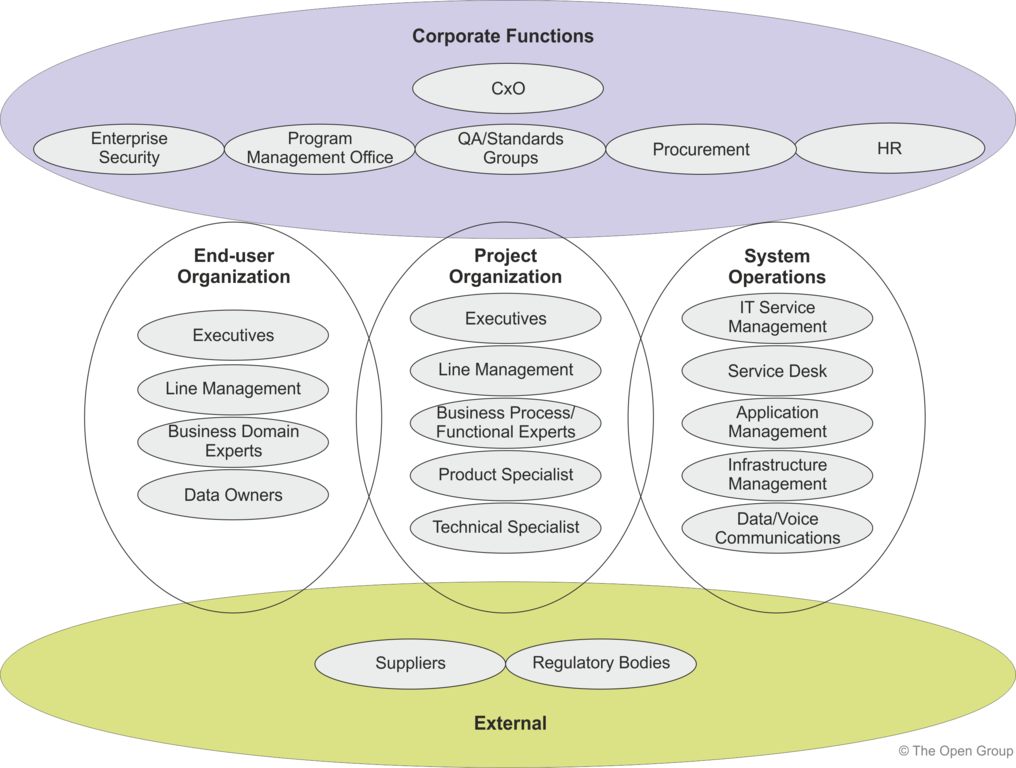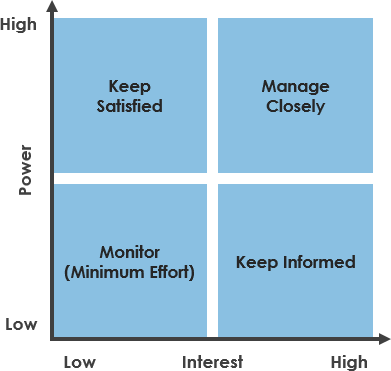Stakeholder management is a critical component to the successful delivery of any project, programme or activity that successful architects can use to win support from others. It helps them ensure that their projects succeed where others fail. A stakeholder is any individual, group or organization that can affect, be affected by, or perceive itself to be affected by a programme. In a nutshell, stakeholder management comprises four steps:
The benefits of successful stakeholder management are:
In TOGAF, the stakeholder management technique should be used during Phase A to identify the key players in the engagement, and also be updated throughout each phase. The output of this process forms the start of the Communications Plan which will be explained later.
Stakeholders may be both organizations and people, ultimately you must communicate with people. Make sure that you identify the correct individual stakeholders within a stakeholder organization.
The first task is to determine who the main enterprise architecture stakeholders are.
A sample stakeholder analysis that distinguishes 22 types of stakeholder, in five broad categories, is shown in as shown in the Figure.

You now need to know more about your key stakeholders. You need to know how they are likely to feel about and react to your project. You also need to know how best to engage them in your project and how best to communicate with them.
Key questions that can help you understand your stakeholders are:
Develop a good understanding of the most important stakeholders and record this analysis (as shown in the example in the table below) for reference and refresh during the project.
| Stakeholder Group | Stakeholder | Ability to Disrupt the Change | Current Understanding | Required Understanding | Current Commitment | Required Commitment | Required Support |
| CIO | John Smith | H | M | H | L | M | H |
| CFO | Paul Davis | M | M | M | L | M | M |
This step enables the team to easily see which stakeholders are expected to be blockers or critics, and which stakeholders are likely to be advocates and supporters of the initiative.
Work out stakeholder power and interest, to focus the enterprise architecture engagement on the key individuals. These can be mapped onto a power/interest matrix, which also indicates the strategy you need to adopt for engaging with them.

Stakeholders may be mapped out on a Power/Interest Grid and classified by their power and interest. There are other tools to map out stakeholders and how to influence them. For example, your boss is likely to have high power and influence over your projects and high interest. Your family may have high interest, but are unlikely to have power over it.
Position on the grid may show actions:
Stakeholder management within businesses, organizations, or projects prepares a strategy using information (or intelligence) gathered during the following common processes. With a clear understanding of your Stakeholders, engaging and communicating can be achieved through a variety of channels based upon who the stakeholder is.
Enterprise architectures contain large volumes of complex and interdependent information. Effective communication of targeted information to the right stakeholders at the right time is a critical success factor for enterprise architecture. In TOGAF, the development of a Communications Plan for architecture in Phase A allows for this communication to be carried out within a planned and managed process.
Typical contents of a Communications Plan are:
| Stakeholder | Communications Method | Frequency | Responsibility | Notes |
| Key Stakeholders | Project Kickoff Meeting | Start of project | Program Management Office | Both Team and Client Kickoff meetings recommended |
| Extranet | Ongoing | Program Management Office | Include project schedule, key project deliverables, meeting minutes, change request log, issues log | |
| Client Executive | Executive Steering Committee | Monthly – first Wednesday of each month | Account Manager | Review status, milestones met, earned value indicators, key issues |
| Chief Sponsor | · Status Meetings
· Status Report (email) |
Weekly – Friday 2 pm | Project Manager | Review project status, schedule, change requests, issues |
| Development team | Status Meetings | Weekly – Friday 11 am | Project Manager | Provides input for a subsequent meeting with the client sponsor |
| Client managers | Newsletter (email) | Weekly – Friday | Project Management Office | |
| Client Sponsor / Key Client Stakeholders | Client Satisfaction Survey | Monthly/End of each phase | Account Manager / Project Manager | · Informal (monthly)
· Formal (end of each phase) |
Identify catalogs, matrices, and diagrams that the architecture engagement needs to produce and validate with each stakeholder group to deliver an effective architecture model.
It is important to pay particular attention to stakeholder interests by defining specific catalogs, matrices, and diagrams that are relevant for a particular enterprise architecture model. This enables the architecture to be communicated to, and understood by, all the stakeholders, and enables them to verify that the enterprise architecture initiative will address their concerns.